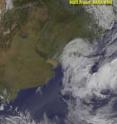GOES satellites see ash still spewing from Chilean volcano
Cordón volcano in Chile continues to spew ash that is still disrupting travel as far as Australia and New Zealand this week. A new animation of satellite imagery just released from the NASA/NOAA GOES Project shows the ash spewing from the volcano. Satellite data from the Geostationary Operational Environmental Satellites called GOES-13 and GOES-11, both managed by NOAA, have been providing images of the volcanic plume since the eruption began on June 4, 2011. Those images were created at NASA's GOES Project located at NASA's Goddard Space Flight Center, Greenbelt, Md. The images were compiled into an animation and sped up to show several days worth of eruptions in less than a minute.
The animation begins on June 24 at 0039 UTC (June 23 8:39 p.m. EDT) and runs 22 seconds. In the animation, the ash plume originally appears very thin as it blows northward. As the time series continues, the plume thickens and blows to the northwest into the Pacific Ocean. The animation ends on June 26 at 23:45 UTC (7:35 p.m. EDT).
Dennis Chesters of the NASA GOES Project noted of the animation, "The Chilean caldera still emits a steady stream of ash, three weeks after the initial eruption. Fortunately, the volume is much less, and the cold winter wind from the south carries it up the coast out over the Pacific, instead of over the Andes into Argentina."
According to CNN on June 28, the volcanic ash cloud was still affecting air travel in New Zealand, Australia. The eruptions of the Puyehue volcano, located in Puyehue National Park in the Andes of Ranco Province of Chile have also caused flight delays and cancellations in Argentina, Brazil, Chile and Uruguay.
Source: NASA/Goddard Space Flight Center
Other sources
- GOES satellites see ash still spewing from Chilean volcanofrom Physorg13 years ago


